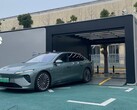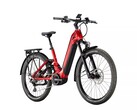1. The Porsche Taycan already conquered 0–60 in 2.6 (real) seconds
Tesla made a big show of comparing the Cybertruck's quarter-mile and 0–60 mph performance to the Porsche 911 — although it made no mention of which 911 trim it used, and it turns out the footage it showed was on a 1/8-mile drag strip. A more fair, apples-to-apples comparison would have featured the Porsche Taycan.
However, it seems as though Tesla pretended the Taycan didn't exist because it didn't want to put the Cybertruck to shame. As it turns out, the Porsche Taycan is a rocket, completing the 0–60 mph sprint in a claimed 2.4 seconds, with some third-party testing seeing numbers as low as 2.4 seconds without any roll-out subtraction needed.
The Cybertruck, on the other hand, claims a 0–60 mph time of 2.6 seconds with roll-out subtracted. Roll-out can add as much as 0.3 seconds to the acceleration time, so subtracting it, like Tesla likes to do, makes a big difference.
Sure, it may be unfair to compare a three-ton stainless steel pickup truck to a low-slung, aerodynamically-optimised sports car, but Tesla itself invited the comparison. To be fair to the Cybertruck, the Porsche Taycan Turbo S that achieves that acceleration is $280,000, while the Cybertruck tops out at $99,990.
To add insult to injury, the Taycan also featured an 800 V architecture four years before the Cybertruck came to market.
2. Rivian beat Tesla to under-bed and locked storage
The Tesla Cybertruck lays claim to 67 cu ft (1,897 l) of locking storage, part of which is an under-bed storage compartment. Tesla may want you to think it's blazing a trail for pickup trucks, both the Rivian R1T and the Ford F-150 Lightning have the Cybertruck beat.
The Rivian R1T, in particular, has handy storage in some unexpected places. Rivian's 11.7 cu ft (331 l) Gear Tunnel is lockable under-bed storage that's accessible without off-loading the bed. The R1T also features an under-bed storage compartment with enough space for a full-sized spare wheel and a frunk with 11.1 cu ft (314 l) of storage space. In total, Rivian claims the R1T has 68 cu ft (1,926 l) of storage, including its vast array of interior storage bins and the covered bed.
It's unclear how Tesla calculates its storage volume for the Cybertruck, but given Tesla's and the automotive industry's tendencies to inflate numbers any way they can, it wouldn't be surprising to learn that Tesla's 67 cu ft (1,897 l) number also includes interior storage.
Either way, the Rivian R1T has the upper hand on the Cybertruck when it comes to storage, and it got there first.
Buy a Peak Design Wireless Charging Mobile Phone Car Mount on Amazon.
3. Ford's F-150 Lightning is cheaper
The pricing of the Ford F-150 Lightning must sting for Elon Musk after his snide remarks about the Blue Oval's electric pickup being too expensive. While the Cybertruck was originally slated to start at $39,000, the launch saw the release of three models, with the cheapest single-motor RWD version coming in at $60,990. The Ford F-150 Lightning starts at $49,995 — $10,995 cheaper.
Even in the best-case scenario where Cybertruck buyers get a $7,500 tax refund, that's still a $3,495 price difference.
To make matters worse, the Ford F-150 Lightning PRO has about the same range — 240 miles (386 km) vs. the Cybertruck's 250 miles (402 km) — and has a dual-motor AWD drive train, while the Cybertruck is only rear-wheel-drive. On top of that, the F-150 Lightning PRO is available to order immediately, as opposed to the entry-level Cybertruck's two-year wait.
Now that Ford will also make use of the Tesla Supercharger network starting in 2024, there's not much of a compelling reason to wait for the Rear-Wheel Drive Cybertruck. That is, unless you absolutely need the extra half a foot of bed space or a frunk that doubles as a bench, for some reason.
4. Even Lucid charged Teslas before the Cybertruck — so did Ford
Another feature that caused quite a stir when the Cybertruck was fully unveiled is Powershare. The Cybertruck is the first Tesla that can do this, thanks to four 120 V outlets for offloading some of its battery power to external equipment at up to 9.6 kW. It can even power a home in an emergency situation at up to 11.5 kW using the 240 V NEMA 14-50 outlet.
The issue is that this is only a first for Tesla. Ford's F-150 Lightning has had Enhanced Pro Power Onboard, capable of delivering 9.6 kW, since it was released. In total, the F-150 Lightning has up to 11 outlets, including an optional 240 V outlet.
More recently, however, the much less utilitarian Lucid Air received a software update that allows the electric sedan to share the same 9.6 kW via a V2V charger.
Buy a Hot Wheels id Tesla Cybertruck 1:64th Scale DieCast model on Amazon.


























